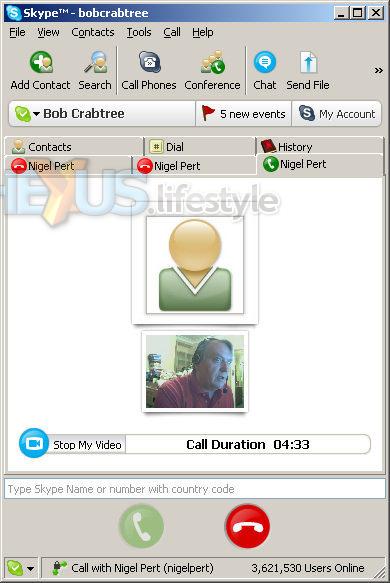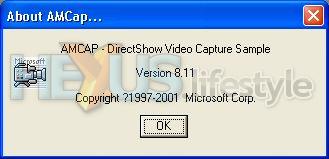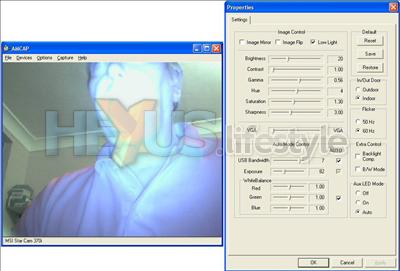Proof of the pudding
Once the installation is complete, the first thing to do is run up AMCap and see if the webcam's working. All three did fire up but our initial take was that they'd all have to be returned because not one of them was working properly!
The live video we were seeing (of ourselves) flared up badly every few seconds. However, we managed to stop the problem after a bit of trial and error. We used the AMCap program to tweak various settings and discovered that turning off the option to have the webcam's see-in-the-dark IR LEDs automatically come on did the trick. Phew! But, it also left us wondering why it is that auto-on seems to be the default.
Overall, we found the picture quality okay but definitely better at night under artificial illumination, which seemed kind of perverse. This was the case whether or not we'd chosen the indoor/outdoor lighting setting using AMCap. Night or day, though, the camera seemed to struggle with clothing of a distinct, uniform colour worn by the person sat directly in front of the camera.
A very dark navy blue jumper came out many shades too light and nothing we did with the settings seemed to help. Also, a brand-new, vivid red T-shirt appeared all washed out - and the only way we could get it roughly the right colour was to bang up the saturation level and ruin the colour of everything else that the camera was capturing.
What struck us as especially strange was that, generally, the colours of everything else in the room - including skin tones - were okay even when the clothing looked wrong. No one is likely to win a cinematography Oscar shooting with the MSI, but we'd be okay living with the colours it produces. If any reservations crept up on us, they'd be easy to dispel just by recalling the ultra-cheap asking price.
We were also happy with the sound - there are no problems to report - as we discovered once we'd checked out two-way videoing using Skype. We're due to receive some interesting and affordable Skype hardware shortly - USB adaptors that let you use conventional phones (including DECT walkabout phones) - and we'll go into further depth about using Skype for video and for voice-only in the first review we write.
For now, suffice it to say that the MSI webcam was immediately recognised by Skype's V2 software and instantly allowed us to use two-way videoing streaming. Results, if anything, seemed rather better than those we were seeing in AMCap's preview window, though we find that inexplicable. And, yes, it is possible to show video at 640 x 480 or even full-screen, not just at the tiny size shown in the shot below!

What has to be said, though, is that our Normandy-based webcam donor is currently struggling with audio and video (in and out) when video streaming with Skype. That's something we're still helping him look into. Our initial thoughts are that the problem may be caused by his internet connection - currently a single ISDN line - but there are other variables, including apps running in the background, that may be contributing. And whatever the cause, we're pretty confident it's not problems with MSI's hardware or drivers. We'll report back, though, as soon as we can.
As a possible interesting aside, the version of AMCap that MSI provides is pretty ancient - it's V8.11 and dates back to 2001.

We discovered a revamped version created by Noël Danjou and released only last month as V9.10 (Build 88.3). It's said to be based on the sample AMCap source code from the Microsoft DirectX 9 SDK and is available for free as a tiny download (174KB) from Noël's site.
Although we haven't spent more than five minutes using it we can say it's caused us no problems being installed alongside the MSI-supplied version. The reason why you might want to check it out is because it has lots of additional features, some of which you may want. The things on the list that caught our attention (none of which we've yet tested) were:
* DV camcorder playback
and recording
* TV tuner support and management
* Still capture in BMP, JPEG and PNG
* Optional real-time compression
* Support for multi-monitor and deinterlacing (using VMR9)
* TV tuner support and management
* Still capture in BMP, JPEG and PNG
* Optional real-time compression
* Support for multi-monitor and deinterlacing (using VMR9)
So, what about using the MSI webcam as a security camera? Well, we were rather surprised at quite how effective it was - as you'll see over on the next page.










